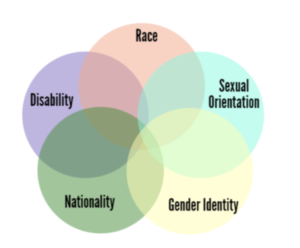
Do you already grasp the nature of sexism, ageism, racism and homo/transphobia? Do you wish to delve deeper into the issues or learn about their relevance in our society. Conscious intersectionality seeks to de-mystify the where, why and how various systems of oppression intersect and how failing to acknowledge such intersections can disempower groups of people by denying them agency.
 Definition of Intersectionality, n. The interconnected nature of social categorizations such as race, class, and gender, regarded as creating overlapping and interdependent systems of discrimination or disadvantage; a theoretical approach based on such a premise. (Oxford Dictionary)
Definition of Intersectionality, n. The interconnected nature of social categorizations such as race, class, and gender, regarded as creating overlapping and interdependent systems of discrimination or disadvantage; a theoretical approach based on such a premise. (Oxford Dictionary)
Intersectionality is a framework for conceptualizing a person, group of people or social problem as affected by a number of discriminations and disadvantages. It accounts for people’s overlapping identities and experiences so as to grasp the complexity of prejudices they face.
To wit, intersectional theory asserts that people are often disadvantaged by multiple sources of oppression: race, class, gender identity, sexual orientation, religion, and other identity markers. Intersectionality sees that identity markers (e.g. female and black) do not exist independently of each other; each informs the others, creating a complex convergence of oppression. For instance, a black man and white woman earn $0.74 and $0.78 to a white man’s dollar, respectively. Faced with multiple forms of oppression, black women earn only $0.64. Understanding intersectionality is key to combatting the interwoven prejudices people face in daily life.
In her 1989 paper, “Demarginalizing The Intersection Of Race And Sex: A Black Feminist Critique Of Antidiscrimination Doctrine, Feminist Theory And Antiracist Politics, law professor and social theorist, Kimberlé Crenshaw, first coined the term intersectionality The theory emerged 20 years earlier, however, when black feminists spoke about the mainstream feminist movement’s white, middle-class nature. Many black women found it tough to identify with the mainstream (white) feminist movement’s issues, like the pressure to be a homemaker. Black women, who often had to work in order to keep their family afloat and thus never had the luxury of being homemakers, did not feel as if these issues pertained to their experiences. At the same time, many black women experienced sexism while participating in the Civil Rights movement and were often denied leadership positions. This intersectional experience of facing racism in the feminist movement and sexism in civil rights encouraged black women to call for a feminist practice that centralized their lived experiences.
In 1978, The Combahee River Collective, a black feminist lesbian organization, released the Combahee River Collective Statement to define and support black feminism. In the introduction these women state that “The synthesis of these oppressions creates the conditions of our lives. As Black women we see Black feminism as the logical political movement to combat the manifold and simultaneous oppressions that all women of color face.” They fought for representation in the Civil Rights and feminist movements, as well as for recognition as black women versus just black or female individuals.
Crenshaw expanded on the Collective’s theory, stating that in order to grasp the oppression of black women, one must explore the intersection of blackness and womanhood. While many who championed intersectionality early on were African American women, the theory is a proven key to understanding an array of differences, including individuals’ sexual orientation, age, class and disability.
Nowadays, intersectionality is deemed crucial to social equity work. Activists and community organizations call for and participate in more dynamic conversations about the differences in experience among thi0se with different overlapping identities. Without an intersectional lens, events and movements that aim to address injustice towards one group may perpetuate systems of inequities towards another group. Intersectionality fully informs many creative and literary artists’ work today by revealing through their art nuanced conversations around inequity. It highlights health disparities among women of color, provides pathways for youth leaders to understand identity, and is crucial to supportive advocacy work.

Did you know that the Conscious Intersectionality theory begs for practical applications in your daily life?
What Can You Do?
No matter how or when you got involved with equity work, you can always more fully integrate intersectionality into your view of these issues.
If you are working towards social equity intersectionality, reflect upon the following:
- Recognize difference. Often, it is easier to believe and explain to others that “all women feel” a certain way or that “LGBTQ+ people believe” some common understanding, but this is false. Know that all unique experiences of identity, especially involving multiple overlapping oppressions, are valid. Do not shy away from recognizing that people experience the world differently based on their overlapping identity markers. Because of how you have been socialized to continue feeding systems of oppression, you may feel that formally recognizing others’ difference is rude. We see this in how people are uncomfortable naming another person’s perceived race or asking for someone’s preferred pronouns. Yet, you should recognize these identities as a way to transcend your assumptions that your experience is common. When you attend rallies, study the signs that others hold. How do they assert their identity and how does this inform their most passionate issues?
- Avoid oversimplified language. Once you consciously see this difference, try to avoid language seeking to define people by a singular identity. After the Women’s March, many trans folks and allies felt uncomfortable with the vagina-centric themes of the march. Assuming the oversimplification that all women have vaginas or are defined by their bodies erases the experiences of those who exist beyond the gender binary. By avoiding language that assumes your own experiences are baseline, you open up to listening to others’ viewpoints.
- Analyze the space you occupy. Becoming comfortable recognizing difference also involves recognizing when that difference is not represented in your own occupied spaces. Diversity of all kinds matter in your workplace, activism, community spaces, and more. If you are meeting with a local LGBTQ+ organization, is there representation of LGBTQ+ people of color? You may assume that your workplace is racially and ethnically diverse, but how accessible is it for the disabled? Observe the welcoming or distancing practices of the spaces you frequent.
- Seek other other points of view. Explore the narratives of those with different interlocking identities than you. This includes surrounding yourself with others with differing interwoven identities, but keep in mind that even when you have a diverse group of people in an activist space, it falls on people to educate others about the oppressions they face. When these people share their experiences, be an active listener. Yet, do not expect people with identity markers other than your own to be there or want to educate others. In your own time, seek out existing intersectional narratives, from podcasts to television. Are you unsure about a concept or wish to learn more about a specific intersection of identity? If so, Google it so as to better prepare yourself to converse with others and progress together.
- Show up. Never expect people who face different systems of oppression than you to rally for your favourite causes if you fail to rally for theirs. As you hear about issues others face, learn about the related work currently being done on them. Listen and defer to those who live with these intersectional identities each day. As you do, you will deepen your understanding of your own identity and the subjects you care about most.
Exploring this concept is tricky as recognizing the presence of intersectionality means you must recognize your own blindspots to understanding oppression and hence, the blindspots in your activism. To unpack these blindspots, you must hold very tough, messy conversations that run the gamut of uncomfortable issues with no stone left unturned. Clearly, you need a safe space to share your truths and life experiences with others. In this way, you can become a more inclusive change agent and better purveyor of humanity in your home and community. If this type of conversation resonates with you, let me know so I can arrange a work shop for other like-minded souls.
\
